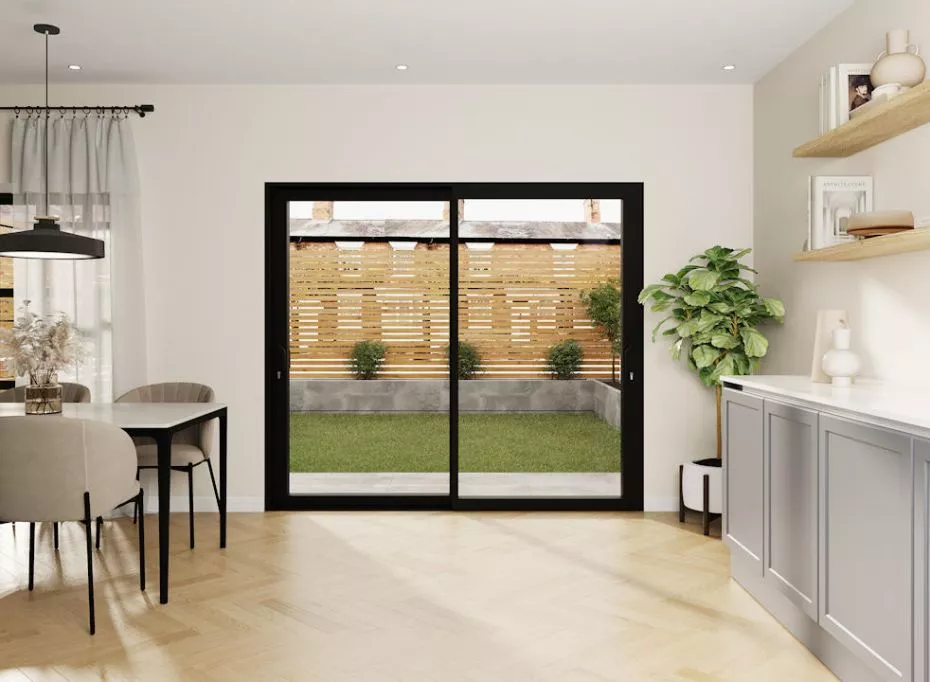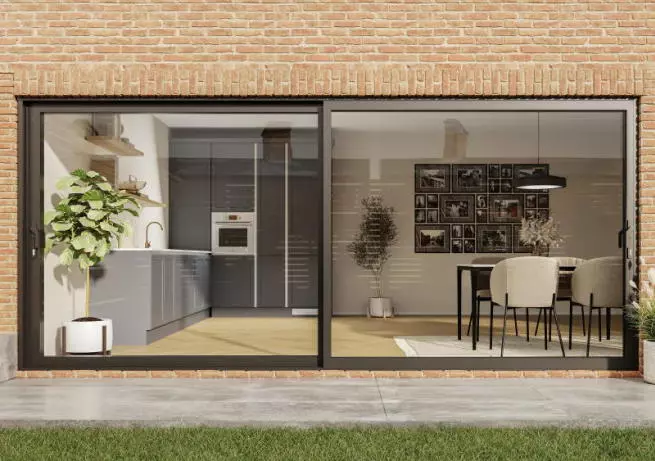What you need to know about sliding door U-Values
Sliding doors are a popular choice for modern homes, offering a sleek design, easy access to outdoor spaces, and abundant natural light. However, their large glass surfaces can significantly impact a property's energy efficiency. One of the most critical factors to consider when selecting sliding doors is their U-Value.
Here, we explore what U-Values are, why they matter, and how they affect the performance of sliding doors.
In this guide:
Read the meaning of sliding door U-Values and why it is important to consider the U-Value of a door.
Read what features impact sliding U-Values.
Read more about the different sliding door materials and the U-Values they typically offer.
Read how sliding doors with low U-Values can help improve the energy efficiency of your home.
We answer common queries on sliding door U-Values.
What are U-Values and why are they important for sliding doors?
U-Values, also known as thermal transmittance values, measure the rate of heat transfer through a material or structure. They indicate how well a building element retains heat. U-Values are expressed in watts per square metre per degree Kelvin (W/m²K), with lower values indicating better insulation and thermal efficiency. Are you choosing a new bifold door? Read our guide to bifold door U-Values here.
Sliding doors can be a significant source of heat loss or retention due to their large glazed areas. Choosing doors with low U-Values can:
-
Reduce heat loss during winter and keep interiors cooler in summer.
-
Lower energy bills by improving thermal efficiency.
-
Create a more comfortable living environment by maintaining consistent indoor temperatures.
In short, sliding doors with low U-Values are essential for energy-efficient homes, particularly in climates with extreme temperature variations.
Key factors affecting the U-Values of sliding doors
Several factors influence the U-Values of sliding doors. Understanding these elements can help you make informed decisions when selecting or upgrading your doors:
1. Material
The frame material significantly impacts a sliding door’s thermal performance. Common materials include:
-
Aluminium: Known for its strength and durability, aluminium frames can achieve low U-Values when combined with thermal breaks. These breaks interrupt the transfer of heat through the metal, improving insulation while maintaining slim sightlines. You can shop our aluminium sliding doors here.
-
Timber: Timber frames offer excellent thermal performance due to their natural insulating properties. They often have some of the lowest U-Values in the market, but may require more maintenance, particularly if they are solid timber rather than engineered wood.
-
uPVC: Cost-effective and low-maintenance, uPVC frames provide a fair level of insulation. However, they may not achieve the slim profiles possible with aluminium, and don’t perform as well when it comes to durability and strength.
Are you looking for the perfect sliding door for your home? Shop our aluminium sliding door range here.
Bring in more natural light with the Supreme sliding door range
Our modern Supreme aluminium sliding doors are a popular choice for many homeowners due to their sleek appearance, durability, and energy efficiency. They are made with high-quality, low maintenance aluminium frames.
These eye-catching modern external sliding door systems are supplied with low-emissivity (low-E) glass, and thermal breaks to further improve their impressive insulation and energy efficiency. Offering U-Values of only 1.6 W/m2K, you are guaranteed exceptional thermal efficiency for your home with our Supreme aluminium sliding door range.
From £2219

2. Glazing
The type and quality of glazing play a critical role in determining U-Values. Consider the following:
-
Double vs triple glazing: Triple glazing typically provides better insulation than double glazing by incorporating an additional pane of glass and insulating gas. Read our complete guide to the different types of glazing here.
-
Low-emissivity (low-E) coatings: These coatings reflect heat back into the room, reducing heat loss.
-
Gas fills: Argon or krypton gas between the panes improves insulation by reducing heat transfer.
3. Installation
Even the most energy efficient sliding doors can underperform if not installed correctly. Proper sealing and alignment are essential to prevent air leaks and ensure optimal thermal performance. It is therefore important to perform regular maintenance checks on your doors. Are you buying a new bifold door? Read our complete guide to bifold door thermal efficiency here.
How do sliding door U-Values compare across materials?
Made from aluminium, our Supreme sliding doors offer U-Values of 1.6 /m2K., whereas our Status sliding doors provide U-Values of only 1.4 w/m2K. With premium design and excellent energy performance, our sliding patio doors will add style, flexibility and security to any home.
Energy efficiency benefits of low U-Value sliding doors
Investing in sliding doors with low U-Values offers several long-term advantages:
Improved thermal comfort
Low U-Value sliding doors help maintain a consistent indoor temperature year-round. During winter, they retain heat, while in summer, they minimise heat gain, reducing the need for air conditioning.
Lower energy bills
By reducing heat loss, low U-Value sliding doors decrease reliance on heating systems. This results in significant energy savings over time.
Reduced carbon footprint
Energy efficient doors contribute to sustainability by lowering energy consumption, reducing your home’s carbon emissions. At Vufold, our sliding doors are also made from aluminium, which is a sustainable material. Find out more about the benefits of aluminium here.
Enhanced property value
Energy efficient features are increasingly attractive to homebuyers. Installing sliding doors with low U-Values can enhance your property’s market appeal and resale value.
Noise reduction
Advanced glazing technologies and well-insulated frames not only improve thermal performance but also reduce external noise, creating a quieter indoor environment.

Frequently asked questions
How do I find the U-Value of my sliding door?
Manufacturers typically provide U-Value ratings for their products. Look for this information in product specifications or certifications.
Can U-values be improved for existing sliding doors?
Yes, you can improve U-Values by:
-
Adding secondary glazing.
-
Applying Low-E coatings to existing glass.
-
Enhancing seals to reduce air leaks.
Are triple glazed sliding doors worth the investment?
Triple glazing can significantly lower U-Values and improve energy efficiency, especially in colder climates. While the upfront cost is higher, the long-term savings and comfort may justify the investment.
Do all sliding doors need to meet the same U-Value regulations?
No, requirements vary based on factors such as location, property type, and whether the project is a new build or renovation.
What role does frame design play in U-Values?
The frame design affects thermal performance. Slim frames with thermal breaks ensure better insulation without compromising aesthetics.
RELATED CONTENT

About John Collins
John has built Vufold into a unique online door and window company and has spent 20 years bringing innovative products and designs to fruition, recognising niches in the market and placing them in the likes of Wickes and Travis Perkins, he started Vufold in order to sell them directly. John founded Vufold and has amassed a wealth of experience in product design and development, and in particular timber-based products
Read more about John Collins

